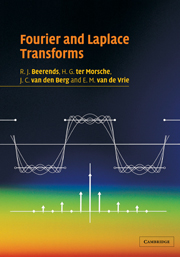Book contents
1 - Signals and systems
Published online by Cambridge University Press: 05 June 2012
Summary
INTRODUCTION
Fourier and Laplace transforms provide a technique to solve differential equations which frequently occur when translating a physical problem into a mathematical model. Examples are the vibrating string and the problem of heat conduction. These will be discussed in chapters 5, 10 and 14.
Besides solving differential equations, Fourier and Laplace transforms are important tools in analyzing signals and the transfer of signals by systems. Hence, the Fourier and Laplace transforms play a predominant role in the theory of signals and systems. In the present chapter we will introduce those parts of the theory of signals and systems that are crucial to the application of the Fourier and Laplace transforms. In chapters 5, 10, 14 and 19 we will then show how the Fourier and Laplace transforms are utilized.
Signals and systems are introduced in section 1.1 and then classified in sections 1.2 and 1.3, which means that on the basis of a number of properties they will be divided into certain classes that are relevant to applications. The fundamental signals are the sinusoidal signals (i.e. sine-shaped signals) and the time-harmonic signals. Time-harmonic signals are complex-valued functions (the values of these functions are complex numbers) which contain only one frequency. These constitute the fundamental building blocks of the Fourier and Laplace transforms.
The most important properties of systems, treated in section 1.3, are linearity and time-invariance. It is these two properties that turn Fourier and Laplace transforms into an attractive tool.
Information
- Type
- Chapter
- Information
- Fourier and Laplace Transforms , pp. 7 - 26Publisher: Cambridge University PressPrint publication year: 2003
